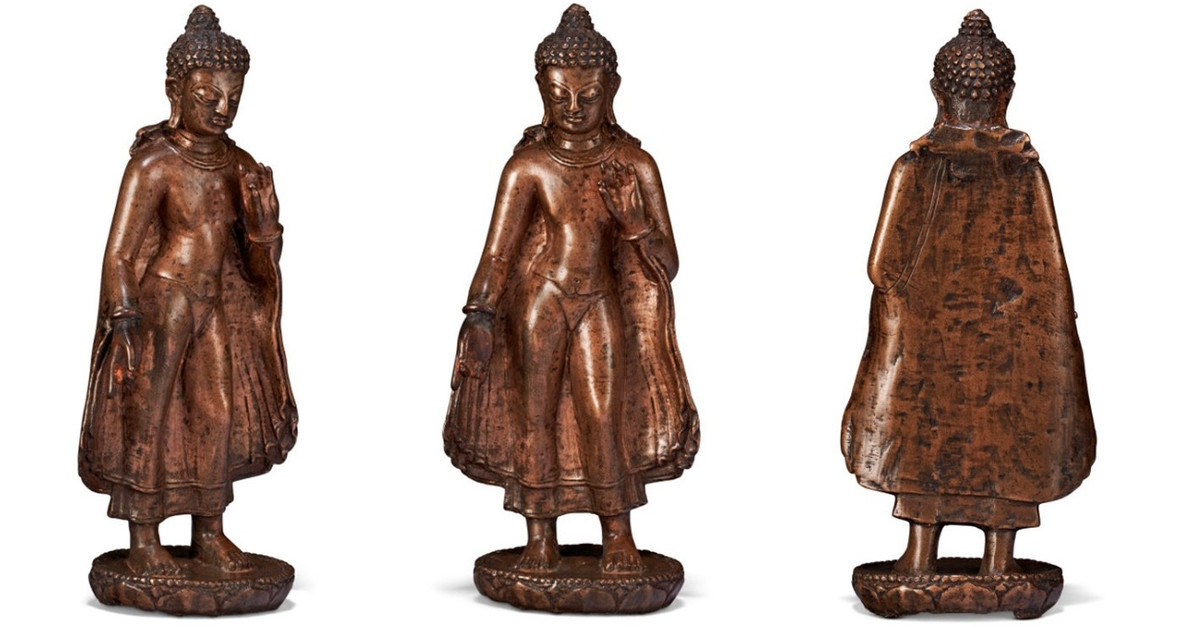The statue of Buddha that was up for sale at Christie’s auction house was, according to art experts, an early test: Would recent controversy around objects once owned by two prominent Chicago collectors hinder its sale and send a signal about how the art market views the renowned collection?
The answer came quickly. The 7 1/4-inch copper-alloy Buddha from 9th-century Nepal, which had been on loan to the Art Institute of Chicago until last year, failed to sell last week, a Christie’s spokesperson said.
It never received a bid in the estimated price range of $60,000 to $80,000.
“Nobody wants to buy trouble,” said Erin Thompson, an associate professor of art crime at John Jay College of Criminal Justice in New York who has advocated for repatriation of Nepali artifacts. “Why would you buy someone else’s stolen cultural property?”
Although the Christie’s auction was a single sale of a single object, art experts said it was telling nonetheless. The rare Buddha had been in the collection of James and Marilynn Alsdorf, whose massive art holdings focused on pieces from Nepal and other parts of South and Southeast Asia.
The Christie’s spokesperson said 63% of the auction’s 124 lots found buyers.
The Alsdorfs obtained the Buddha at a time when protocols around collecting were lax, and it was sold to them by a New York dealer who at the end of his career acknowledged engaging in questionable practices. Ethical standards for acquiring antiquities became more strict after a 1970 UNESCO convention prohibited the import of looted cultural property.
The Buddha was on loan to the Art Institute beginning in the late 1990s and was last on display in 2018 at the museum, which has galleries dedicated to the Alsdorfs’ vast Asian collection. Marilynn Alsdorf, who died in 2019, left much of the collection to the museum. James Alsdorf, who once led the museum’s board of trustees, died in 1990.
Last week, ProPublica and Crain’s Chicago Business published an investigation into Nepal’s claims that the Art Institute should return a 17th-century gilt-copper necklace that is on display in its Alsdorf Galleries, as well as questions about other objects in the couple’s collection.
The investigation identified nine pieces once owned by the Alsdorfs that have been returned to other countries based on concerns they were looted or illicitly exported, a pattern some art historians said should spur the Art Institute to take a deeper look at the approximately 500 Alsdorf objects in its collection.
The investigation also showed that the Art Institute hasn’t kept up with other museums that take a more transparent approach to these problems by publicly sharing information when an object is repatriated.
Marilynn Alsdorf’s son, Jeffrey Alsdorf, did not respond to requests for comment. He is listed as an executor of his mother’s estate and sits on the board of the Alsdorf Foundation, according to the most recent publicly available tax records. Linda Feinstein, a Chicago attorney who, according to records, has represented Marilynn Alsdorf’s trust, also did not respond to a request for comment.
The Buddha up for sale at Christie’s was taken off display at the Art Institute in 2018 when the museum reinstalled its galleries, a museum spokesperson said. After Marilynn Alsdorf’s death, all of her remaining loans to the museum were concluded in 2022, the spokesperson said.
The Art Institute has said it follows best practices for investigating and documenting ownership history, or provenance, of the objects in its collection and has added staff dedicated to that process. The museum also has said it takes all repatriation claims seriously but has noted that they’re complex and often take time to resolve.
The fate of the rare Buddha is not unlike what’s happened when other controversial objects have gone up for sale. Bronzes from the West African country of Benin that were stolen by British colonialists have failed to sell or have been pulled from bidding before auctions begin. Museums are now repatriating the objects to Nigeria.
Pieces from Italy and Greece have also recently been removed from auctions after researchers linked their provenance to known antiquities smugglers and publicized concerns about them.
In such cases, prospective buyers may be worried about the potential resale value of an object that has garnered controversy, said Patty Gerstenblith, a distinguished research professor specializing in cultural heritage law at DePaul University.
“I might say to myself, ‘Am I buying a lawsuit? Am I buying bad publicity?’” Gerstenblith said. “There’s a lot of short-term and longer-term concerns, and I do believe that once something is out there, it can influence the market.”
This isn’t the first time that bidders have been wary of an Alsdorf piece on the auction circuit. In June 2020, a Benin bronze sculpture of a fish, acquired by the Alsdorfs in 1957, failed to sell at a Christie’s auction in Paris, according to news reports.
In the most recent auction, the Buddha up for sale had been purchased by the Alsdorfs from an art dealer named William Wolff, who had acquired it by 1972, according to information from Christie’s. It isn’t clear when the Alsdorfs purchased the piece from him.
For years, Wolff had a gallery on Madison Avenue in New York City. Although he was widely considered one of the nation’s top dealers in Asian antiquities, Wolff acknowledged near the end of his career that some of his dealings had occurred under questionable circumstances.
Wolff, who died in 1991, said that in many countries where he acquired objects, their export was illegal. He said he utilized a network of “scouts” to transport the pieces, sometimes across mountain ranges.
“The fellows I bought from knew how to get it out of the country,” he told the Los Angeles Times in 1990, when he closed his gallery because of rising rent. “Otherwise they would not have been able to sell it.”
For Nepalis, the increased attention on cultural artifacts in museums and private Western collections is long overdue. Activists with the Nepal Heritage Recovery Campaign, an organization that works to repatriate stolen objects to the country, have been pressing the Art Institute to return more objects donated to the museum by the Alsdorfs, who were major financial supporters of Chicago’s arts community.
A gilt-copper necklace at the Art Institute is perhaps the strongest symbol of the questions plaguing the Alsdorf collection. The Nepali government first asked the Art Institute to return the necklace in August 2021, alleging the piece had been stolen from a secure location in Nepal and illicitly exported from the country. The necklace is said to have been offered to the Hindu goddess Taleju by a Nepali king in about 1650.
The slow pace of negotiations has frustrated Nepali activists, art historians and cultural heritage scholars following the case. New details reported by Crain’s and ProPublica showed that the Art Institute asked Nepal to provide more evidence establishing ownership of the necklace, despite the decades that have passed since the piece went missing from the country.
Following the ProPublica-Crain’s investigation, Gerstenblith said it’s unlikely those records exist. She called on the Art Institute to return the necklace if Nepal can show it came from the country and has ongoing cultural significance to its people.
“To ask a country to come up with that type of documentation is as if they’re in a court of law,” Gerstenblith said. “It’s my opinion that the point of having an ethical policy is to actually move beyond that and, if anything, to shift the burden to the Art Institute.”



